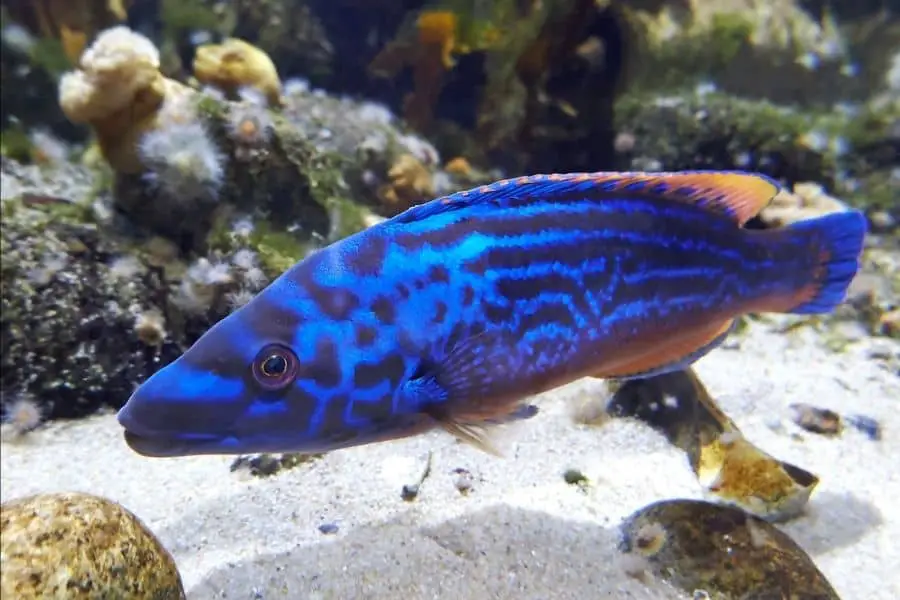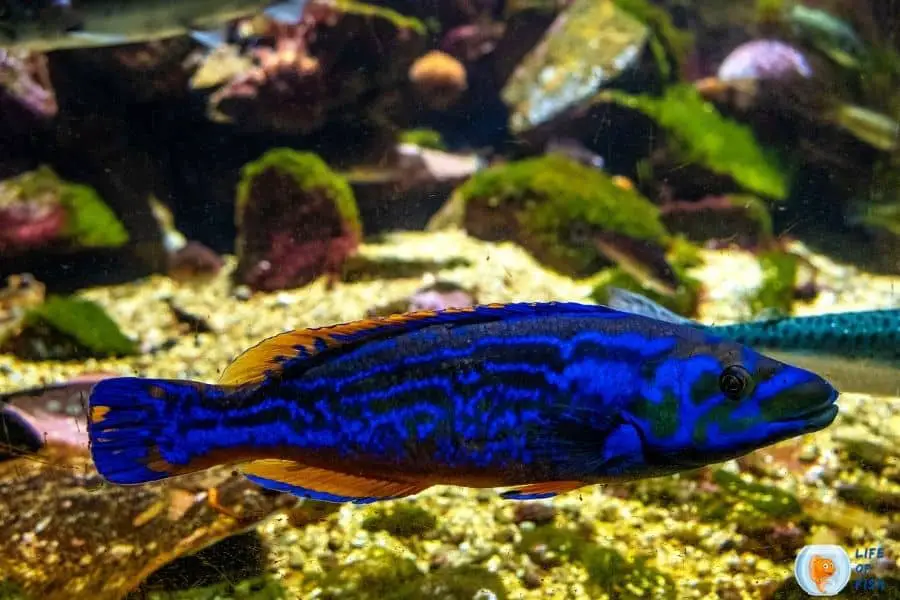The ocean is full of hidden wonders, but few are as striking as the Cuckoo Wrasse. With its bold and vibrant colors, this fish stands out in even the most diverse and colorful coral reefs. But the Cuckoo Wrasse isn’t just a pretty face – it has a fascinating life cycle and behavior that has captivated marine biologists for years.
Whether you’re a seasoned diver or simply a lover of marine life, encountering the Cuckoo Wrasse is an experience you won’t soon forget. Let’s find out how to care for them in this article.

What is Cuckoo wrasse?
Jump To
Cuckoo wrasse (Labrus mixtus) is a species of wrasse that belongs to the genus Labrus. They are often found in the Eastern Atlantic ocean, from Southern Norway to Senegal, Azores, and Madeira.
These fish are occasionally encountered in the Mediterranean Sea. They inhabit algal zones of rocky shores at depths of 30 to 80 meters. They are non-migratory fish, which means they move according to the tide and depth of their home, but not long distances. These fish usually prefer solitary. However, it is normal to encounter them in pairs or with juvenile fish.
Discover the beauty and complexity of wrasse fish in our comprehensive article!
How Cuckoo wrasse looks like
They are one of the most colorful fish that shows sexual dimorphism. There are distinct differences between males, females, and even juveniles.
Color
The male fish has a blue head in an orange body. The body is covered with horizontal brilliant blue lines and mottled patterns. The tail is dark blue, while the other fins are covered with blue markings on the margins. Juveniles and females are colored in a combination of pink, orange, and red. However, females have three black spots on their backs near the dorsal fin, which juveniles lack. They possess white coloration between the black spots, stretching to the tail.
Shape
The body is slim and elongated, and it has a long, pointed head. Like other wrasse species, they are ray-finned fish that have long dorsal spines on the back. Their eyes are big and round. Males have bigger heads than females do.
Size
They grow up to 16 inches maximum in length, with an average size of 12 inches. They are among one of the largest wrasse species. Like most fish, their growth is faster when they are in their juvenile stage and gradually slows down in adulthood.
The female Cuckoo wrasses are usually smaller than the males. The maximum size of a female specimen is about 12 inches.
Life span
They have a maximum life span of 20 years. Their average life expectancy is about 10 to 12 years in the wild.
Where Cuckoo wrasse lives?
They inhabit weedy and rocky areas near the coral reefs. They are found in the eastern Atlantic Ocean and the Mediterranean Sea. It is common in the coastal waters of Norway, Senegal, Azores, and Madeira. They also occur in the Canary Islands and Cyprus but are absent from the Levantine Sea.
They usually live at the depth of 40 to 80 meters (130 and 260 ft), but you can also see them at a depth of 2 meters and 200 meters. As non-migratory fish, so they live in a limited area. These fish prefer a water temperature of 20 to 24 degrees Celsius (68-75 °F). Their pH preference ranges from 7.8 to 8.4, which is slightly alkaline.

Their behavior
They prefer to live in solitary, but they may also live in pairs or with juvenile fish. They prefer slightly deeper water than the Ballan wrasse and rarely occur in shallow waters. However, juveniles occasionally live in shallower waters. These fish become aggressive and territorial when breeding, and the males show parenting behavior, unlike most other wrasse species.
Cuckoo wrasses are protogynous hermaphrodites, which means they can change sex under certain circumstances. All cuckoo wrasse are born females.
When a wrasse group lacks a male for reproduction, the dominant female will transform into a male. Usually, there can be only one male in a group. The group can sometimes lose the male when other fish predate on the male or die for different reasons. The dominant female fish takes about seven months for sex reversal.
They eat plankton, crustaceans, mollusks, and worms with their tiny canine-like teeth. They also swallow sand to digest food better. When they mate, it is common for large males to chase smaller males away.
What does Cuckoo wrasse eat?
They are carnivore fish, which means they feed on microscopic organisms or animals. This includes crustaceans, mollusks, worms, and even fish. They also swallow sand to digest food better. This fish prefers feeding in the middle of the day when they are less visible because of sunlight.
Divers can sometimes see them during the daytime, but usually at night. Juveniles are more active in the early morning and late afternoon.
Cuckoo wrasse breeding
These fish are oviparous, which means females lay eggs instead of giving birth to live young. They spawn in a pair or a group. The male and female will circle each other for about an hour to figure out if they are ready for mating. Once they are ready, the male releases sperm, and the female releases eggs simultaneously.
For spawning, the male builds a dish-shaped nest with algae, and that is where these fish lay their eggs. The female fish can lay up to thousand eggs in one spawn. During the mating season, male cuckoo wrasse becomes territorial, and females are often chased away or attacked by males.
Work on territory starts when they find their home in the algal zone. Males take every chance to fight with their neighbors to expand their territory. But this is done without much harm. Once they finish spawning, the male fish guard the eggs until they hatch to protect them from predators, including other wrasse species.
Importance of Cuckoo wrasse
Ecosystem balance
These colorful fish are secondary predators, which means they prey on other small fishes in the water. They also take part in the daily feeding of bigger predators, such as sharks and rays. Taking part in the ecosystem balance is important to ensure the environment’s survival. Cuckoo wrasses are also helpful because they clean up sea environments by eating parasites that grow on other fish species.
Sportfishing
Recreational anglers are catching cuckoo fish as game fish. They are popular in sportfishing because of their fights, size, and shape suitable for catching. However, anglers fish for these fish on a catch-and-release basis because increased fishing can affect their populations.
As a food
Occasionally, cuckoo wrasses are captured commercially as food. But, their flesh is not popular in many places, including Britain.
Other uses
Cuckoo wrasses are essential to Norway’s salmon farming industry. They help keep the population of pesky fish lice in check, which is crucial for sustainable fishing practices. However, there have been some negative impacts on this species as well – often, not enough individuals can be found throughout certain areas due to an overfishing problem that continues across the country.
Can you eat Cuckoo wrasse?
This fish can be eaten after being cooked. However, their flesh is not popular in many places, including Britain. They are caught for food occasionally, but they don’t have much demand in the market.

Does wrasse taste good?
Wrasse flesh is more like dogfish that has a sweetish flavor. Some people love this taste, but some do not. Most people do not prefer eating wrasse because of their bones. They say that it is hard to skin and debone a wrasse. Otherwise, wrasse is pretty much edible fish that has a pleasant taste.
How do you cook cuckoo wrasse?
Although they are bony, they are tasty when cooked in certain ways. They are delicious when prepared as a soup. You can also remove the scales and roast or bake the fish in whole after wrapping it in foil. Or You can also fry or steam it. You can also prepare cuckoo wrasse by making a fishball soup served with chili sauce, soy sauce, or coriander.
Tip: If you find it hard to remove the scales of these fish, here is a tip. Pour some boiling water over the fish, and then you can easily remove the scales by scraping them off with a spoon. They are not common in the market, so they are very hard to find even if they are edible. They are mainly served in Norwegian seafood restaurants.
Related Question
What kind of fish is a Cuckoo wrasse?
They are ray-finned fish belonging to the Labridae family. They are related to some of the popular aquarium wrasse species, but these fish are not kept as aquarium fish in home aquaria. However, they are popular in public aquaria because they are unique and attractive species. They are ectothermic marine fish that you can find in rock pools on Atlantic coasts. This fish can grow up to 16 inches long, but adults usually reach the size of 12 inches. Their lifespan is about ten years.
Are Cuckoo wrasses rare?
They are common fish, but their populations have decreased in some places because of overfishing. This makes them vulnerable to extinction. However, they are abundant in most of their native habitats, making them the Least Concerning species on the IUCN Red List.
Are Cuckoo wrasses poisonous?
They are not poisonous and are actually edible. However, their meat is not well-liked in many nations, such as Britain. Further, their dorsal spines can harm human skin, leading to painful injury.
Conclusion
Cuckoo wrasse is a beautiful wrasse species that are sold occasionally in some markets. They are edible after being cooked, but their flesh is not popular. Therefore, these fish are not popular as food fish but as game fish. Most anglers catch and then release these fish because it takes a long time for these fish to reproduce.
Cuckoo wrasses are helpful as secondary predators and fishes that clean up other fishes from parasites. They also help with the balance of sea ecosystems by preying on smaller fish and crustaceans.
Overfishing by humans is the most serious threat to the survival of wrasses. This has caused a reduction in the population of many species, such as Cuckoo wrasse. As a result, their populations in some countries have reached an endangered status, and others are threatened by extinction.
Read Next : Bluestreak Cleaner Wrasse Eight line Flasher Wrasse Care | There Are More To Learn |
